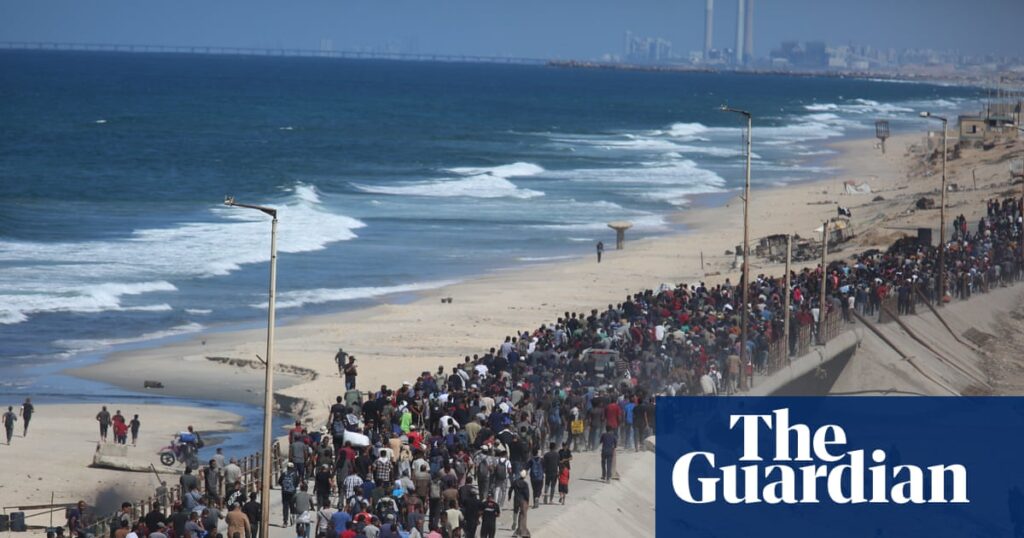NepalIsrael.com auto goggle feed
Thousands of displaced Palestinians have begun to return home from southern Gaza after a ceasefire came into effect and Israeli troops withdrew to an agreed-upon redeployment line – the first time that fighting has stopped in the devastated territory since March.
The Israeli military said the ceasefire agreement, which was approved by the Israeli cabinet on Thursday night and begins the first phase of a US-drafted plan to end the war in Gaza, had been activated at noon local time (0900 GMT) on Friday.
Under the terms of the plan, Hamas is expected to release the 20 living Israeli hostages within 72 hours, after which Israel will release 250 Palestinians serving long terms in Israeli prisons, as well as 1,700 others detained in Gaza during the war.
The Israeli prime minister, Benjamin Netanyahu, claimed credit for the hostage release, saying in an address on Friday that the “security of Israel” was what dictated his actions in Gaza.
“I believed that if we applied heavy military pressure, combined with heavy diplomatic pressure, we would absolutely be able to return all of our hostages,” said Netanyahu, who also thanked the US president, Donald Trump, for his support to achieve the deal.
Avichay Adraee, an Israeli Arabic-language military spokesperson, said residents of Gaza could return north via specific routes, while warning them away from areas such as Beit Hanoun and the Rafah border crossing, where troops remained. Israeli bombing in Gaza had intensified on Friday morning up until the ceasefire began.
According to an Israeli government spokesperson speaking on Thursday, Israeli forces will remain in control of 53% of Gaza in the initial withdrawal phase before the hostages are released. Israeli troops were seen pulling back from areas such as the eastern part of Khan Younis, southern Gaza, and the Nuseirat camp in central Gaza, but troops were still visible in other parts of the strip.
With the announcement that a ceasefire had begun, a massive column of Palestinians began filing north towards Gaza City, the territory’s biggest urban area. Nearly half a million Palestinians living in north Gaza had been displaced by Israel’s military operation in Gaza City, and many of them were eager to return to their homes.
Footage showed huge crowds on the coastal road, which had been cut off for returnees just days prior.
“Thank God my house is still standing,” said 40-year-old Ismail Zayda in the Sheikh Radwan area of Gaza City. “But the place is destroyed, my neighbours’ houses are destroyed, entire districts have gone,” he told Reuters.
The ceasefire is meant to be accompanied by a surge in humanitarian and medical aid into Gaza through all five crossings into the besieged strip. Israel will allow 600 aid trucks into Gaza each day, according to Israeli Army Radio, which is roughly equivalent to prewar levels.
The aid is sorely needed as malnutrition is rife in the strip, parts of which are in the throes of famine, according to the world’s leading authority on food crises.
Medical workers announced that they would use the ceasefire period to start recovering bodies trapped under rubble. Tens of thousands of bodies are expected to be under the debris of ruined buildings, as fighting made excavation and recovery difficult.
Khalil al-Hayya, a senior Hamas official and lead negotiator for the group, said he had received international guarantees that the war was over.
However, much of Trump’s 20-point plan to end the two-year war still needs to be ironed out by negotiators. Trump’s plan also calls for Hamas to disarm, for the Gaza Strip to be governed by an international transitional government, and for a full Israeli withdrawal to a buffer zone on the strip’s border.
The topic of Hamas’s arms, as well as the makeup of the transitional authority, is expected to be more of a challenge to negotiators than the exchange of hostages and detainees. Hamas and Israel have sharply differing visions on both topics.
Nonetheless, Israeli TV’s Channel 12 reported that Trump would visit Israel on Monday to deliver a speech at the Knesset in Jerusalem.
Friday’s ceasefire is the first cessation in fighting in more than six months and the closest that Israel and Hamas have come to permanently ending the war in Gaza.
Israel’s two-year military campaign in Gaza killed more than 67,000 Palestinians and wounded nearly 170,000 more, according to the Gaza ministry of health. Tens of thousands more bodies are expected to be buried under the rubble.
Israel launched the war in response to a Hamas-led attack on 7 October 2023 that killed about 1,200 people and took 251 hostage.
A UN commission of inquiry and several human rights bodies have accused Israel of conducting a genocide in Gaza over the past two years. Israel denies the accusation and says it has only acted in self-defence.
The post”Palestinians displaced to southern Gaza begin journey home as ceasefire comes into effect | Gaza” is auto generated by Nepalisrael.com’s Auto feed for the information purpose. [/gpt3]




